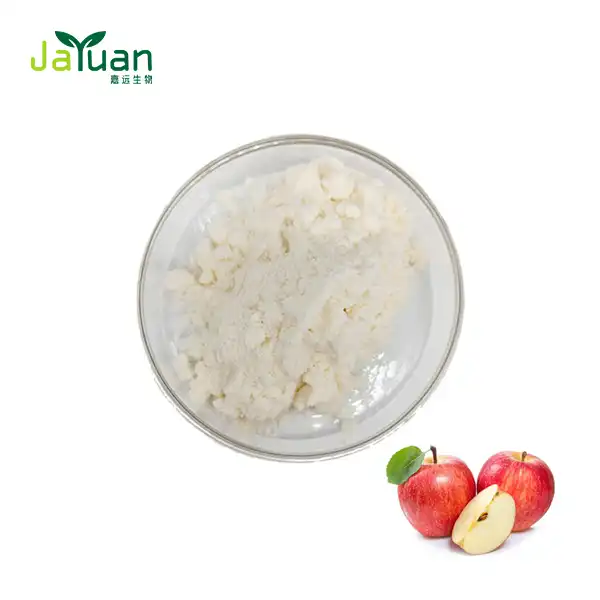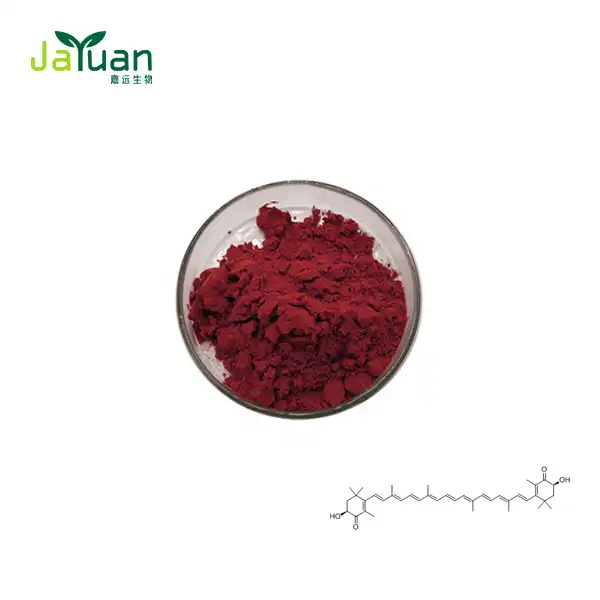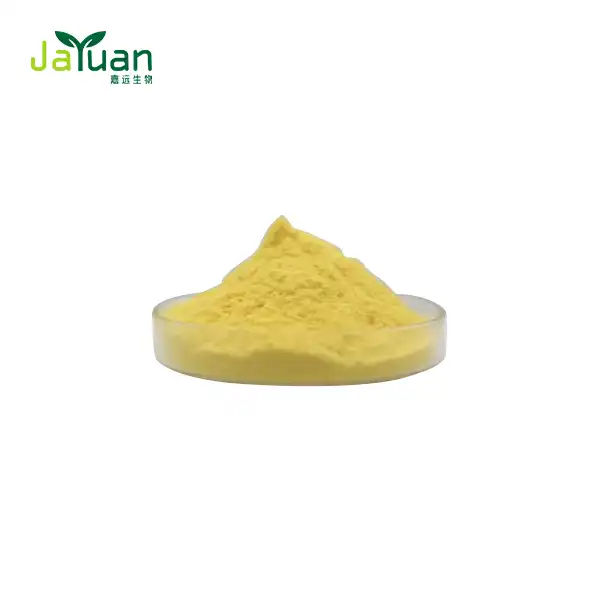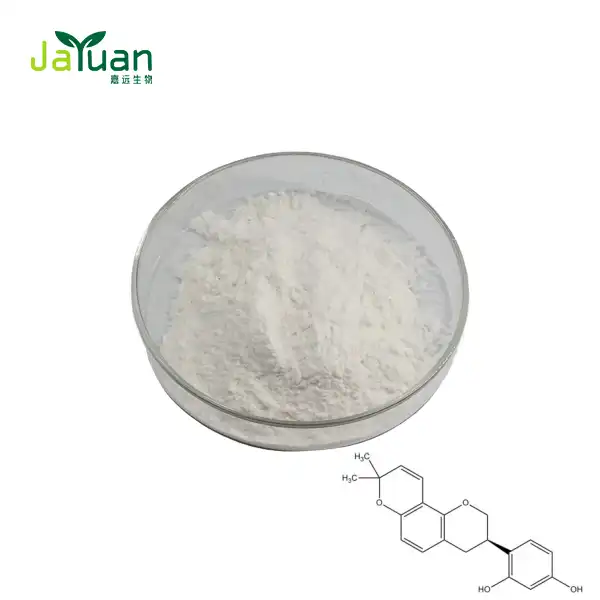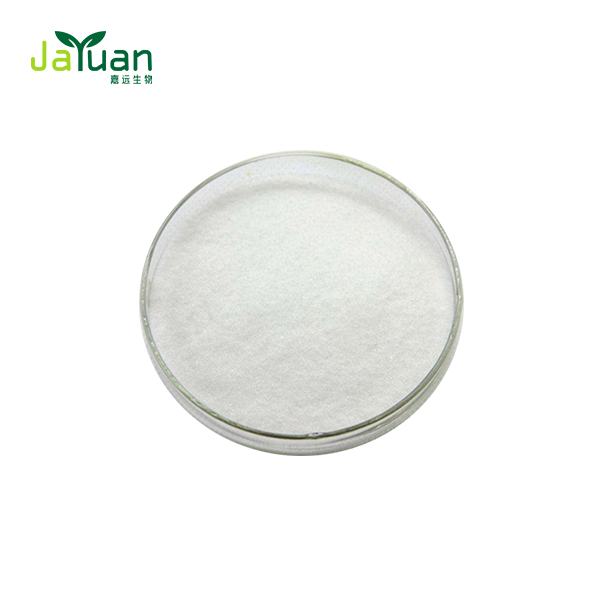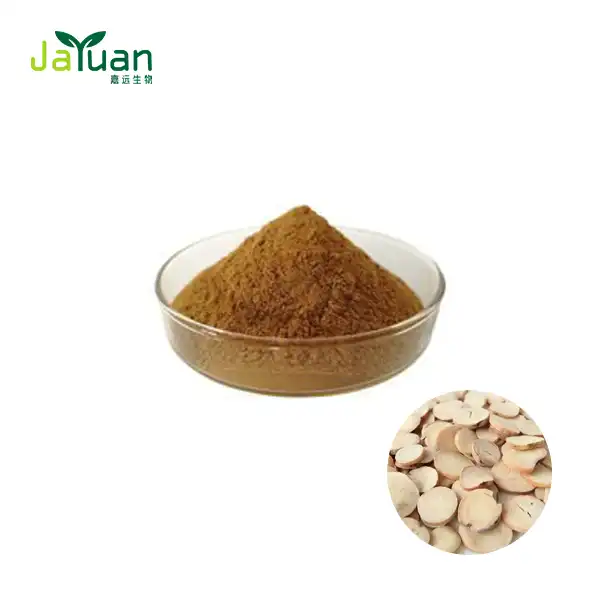What is the difference between curcumin and Tetrahydrocurcumin?
Curcumin and tetrahydrocurcumin powder are both compounds derived from turmeric, but they have distinct characteristics and benefits. This article will explore the key differences between these two powerful substances, focusing on their chemical structure, bioavailability, and potential skin health benefits. Understanding these differences can help you make informed decisions about which compound may be more suitable for your specific needs.
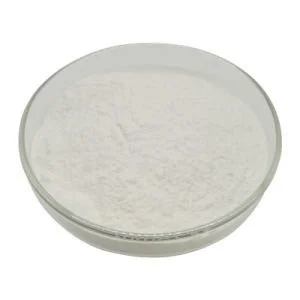
Chemical Structure: Curcumin vs. Tetrahydrocurcumin Compared
Curcumin and tetrahydrocurcumin share a similar foundation but have notable structural differences that impact their properties and effectiveness:
- Curcumin: This yellow pigment is the primary active compound in turmeric. It has a distinctive chemical structure characterized by two aromatic rings connected by a seven-carbon chain. The presence of conjugated double bonds in this chain contributes to curcumin's vibrant yellow color and its ability to act as a powerful antioxidant.
- Tetrahydrocurcumin: As a metabolite of curcumin, tetrahydrocurcumin has a similar overall structure but with one crucial difference. The conjugated double bonds in the central chain have been reduced, resulting in a colorless compound. This structural modification leads to enhanced stability and altered properties compared to its parent molecule.
The reduction of these double bonds in tetrahydrocurcumin powder results in several key differences:
- Increased stability in various pH environments
- Enhanced solubility in aqueous solutions
- Improved resistance to degradation
- Altered antioxidant mechanisms
These structural variations play a significant role in how each compound interacts with the body and its potential applications in various fields, including nutraceuticals and cosmetics.
Is Tetrahydrocurcumin More Bioavailable Than Curcumin?
Bioavailability is a crucial factor when considering the efficacy of any compound. In the case of curcumin and tetrahydrocurcumin, there are notable differences in how well the body can absorb and utilize these substances:
Curcumin Bioavailability:
- Generally low due to poor absorption and rapid metabolism
- Quickly transformed in the gut and liver
- Often requires additional compounds or delivery systems to enhance absorption
Tetrahydrocurcumin Bioavailability:
- Exhibits superior absorption compared to curcumin
- More stable in physiological conditions
- Longer half-life in the body
- Does not require extensive metabolic conversion
Research has shown that tetrahydrocurcumin powder demonstrates enhanced bioavailability compared to standard curcumin. This improved absorption is attributed to several factors:
- Increased solubility in aqueous environments, facilitating easier uptake by cells
- Greater stability in the gastrointestinal tract, allowing more of the compound to reach the bloodstream intact
- Reduced susceptibility to enzymatic degradation, prolonging its presence in the body
- Direct cellular uptake without the need for extensive metabolic conversion
These factors contribute to tetrahydrocurcumin's ability to maintain higher concentrations in the bloodstream for extended periods, potentially leading to more pronounced biological effects. The enhanced bioavailability of tetrahydrocurcumin makes it an attractive option for those seeking to maximize the potential benefits of curcuminoids without the need for complex delivery systems or high doses.

Why Choose Tetrahydrocurcumin for Skin Health?
Tetrahydrocurcumin has picked up noteworthy consideration in the skincare industry due to its special properties and potential benefits for skin well-being. Here are a few reasons why tetrahydrocurcumin powder bulk is getting to be a prevalent choice for skin-related applications:
- Powerful Antioxidant Properties: Tetrahydrocurcumin shows strong antioxidant action, indeed outperforming that of curcumin in a few ponders. This effective antioxidant capacity makes a difference in securing skin cells from oxidative push caused by free radicals, natural poisons, and UV radiation. By neutralizing these destructive particles, tetrahydrocurcumin may offer assistance keep up skin astuteness and advance an energetic appearance.
- Improved Steadiness and Colorless Nature: Unlike curcumin, which has a dynamic yellow color that can recolor skin and clothing, tetrahydrocurcumin is colorless. This property makes it perfect for utilization in a wide extend of skincare details without changing the product's appearance. Also, its upgraded soundness guarantees that the dynamic compound remains successful for expanded periods, indeed when exposed to light or changing pH conditions.
- Skin-Brightening Effects: Tetrahydrocurcumin has appeared to restrain tyrosinase, a chemical significant in the generation of melanin. By tweaking melanin amalgamation, tetrahydrocurcumin may offer assistance to advance a more indeed skin tone and address issues related to hyperpigmentation. This skin-brightening impact makes it an important fixing in items aimed at making strides skin brilliance and diminishing the appearance of dim spots.
- Anti-Inflammatory Properties: Inflammation plays a noteworthy part in different skin concerns, including skin breakout, rosacea, and untimely maturing. Tetrahydrocurcumin has anti-inflammatory properties that may offer assistance relieve aggravated skin and decrease redness. By relieving aggravation, it can contribute to a calmer, more adjusted complexion.
- Collagen Support: Some consider propose that tetrahydrocurcumin may offer assistance to foster collagen generation and ensure existing collagen from corruption. Collagen is basic for keeping up skin flexibility and solidness. By advancing collagen well-being, tetrahydrocurcumin may contribute to making strides in the skin surface and diminish the appearance of fine lines and wrinkles.
- Progressed Penetration: The upgraded solvency and steadiness of tetrahydrocurcumin may lead to way better skin entrance compared to curcumin. This progressed capacity to enter the skin's layers might result in a more viable conveyance of its advantageous properties to target zones, maximizing its potential skincare benefits.
Conclusion
The differences between curcumin and tetrahydrocurcumin highlight the importance of understanding the nuances of natural compounds and their derivatives. While both substances offer potential benefits, tetrahydrocurcumin's enhanced bioavailability and unique properties make it an exciting option for various applications, particularly in the realm of skin health.
As the demand for effective, natural-based ingredients continues to grow, compounds like tetrahydrocurcumin are likely to gain more attention from researchers, formulators, and consumers alike. By leveraging the strengths of these compounds, we can develop more targeted and efficient products that harness the power of nature to promote overall well-being.
If you're interested in exploring the potential of tetrahydrocurcumin for your products or research, consider reaching out to reputable suppliers who can provide high-quality tetrahydrocurcumin powder and offer guidance on its applications. With ongoing research and innovation in this field, the future looks bright for tetrahydrocurcumin and its potential to revolutionize various industries, from nutraceuticals to cosmetics.
For more information about our high-quality tetrahydrocurcumin powder and other plant extracts, please don't hesitate to contact us at sales@jayuanbio.com, sales1@jayuanbio.com. Our team of experts is ready to assist you in finding the perfect solution for your specific needs and applications.
References
1. Aggarwal, B. B., & Harikumar, K. B. (2009). Potential therapeutic effects of curcumin, the anti-inflammatory agent, against neurodegenerative, cardiovascular, pulmonary, metabolic, autoimmune and neoplastic diseases. The international journal of biochemistry & cell biology, 41(1), 40-59.
2. Lai, C. S., Wu, J. C., Yu, S. F., Badmaev, V., Nagabhushanam, K., Ho, C. T., & Pan, M. H. (2011). Tetrahydrocurcumin is more effective than curcumin in preventing azoxymethane-induced colon carcinogenesis. Molecular nutrition & food research, 55(12), 1819-1828.
3. Murugan, P., & Pari, L. (2006). Antioxidant effect of tetrahydrocurcumin in streptozotocin–nicotinamide induced diabetic rats. Life sciences, 79(18), 1720-1728.
4. Okada, K., Wangpoengtrakul, C., Tanaka, T., Toyokuni, S., Uchida, K., & Osawa, T. (2001). Curcumin and especially tetrahydrocurcumin ameliorate oxidative stress-induced renal injury in mice. The Journal of nutrition, 131(8), 2090-2095.
5. Somparn, P., Phisalaphong, C., Nakornchai, S., Unchern, S., & Morales, N. P. (2007). Comparative antioxidant activities of curcumin and its demethoxy and hydrogenated derivatives. Biological and Pharmaceutical Bulletin, 30(1), 74-78.
6. Yodkeeree, S., Chaiwangyen, W., Garbisa, S., & Limtrakul, P. (2009). Curcumin, demethoxycurcumin and bisdemethoxycurcumin differentially inhibit cancer cell invasion through the down-regulation of MMPs and uPA. The Journal of nutritional biochemistry, 20(2), 87-95.

